
Chives, scientific name Allium schoenoprasum, is a species of flowering plant in the family Amaryllidaceae that produces edible leaves and flowers. Their close relatives include the common onions, garlic, shallot, leek, scallion, and Chinese onion.

Triadenum, known as marsh St. John's worts, is a small genus of flowering plants in the family Hypericaceae. The genus is characterized by opposite, blunt-tipped leaves and pink flowers with 9 stamens. They are distributed in North America and eastern Asia.
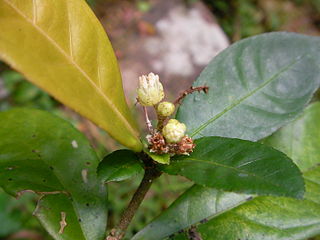
Croton hanceiBenth., the Hong Kong croton, is a shrub or small tree, a species of Croton which is endemic to Tsing Yi Island, Hong Kong. In Hong Kong, it is listed in the book Rare and precious Plants of Hong Kong.

Mollugo verticillata, the green carpetweed, is a rapidly spreading annual plant from tropical America. In eastern North America, it is a common weed growing in disturbed areas. It forms a prostrate circular mat that can quickly climb over nearby plants and obstacles. The species has been reported from every state in the United States except Alaska, Hawaii, and Utah, as well as from British Columbia, Manitoba. Ontario, Quebec, New Brunswick and Nova Scotia. Although considered an invasive weed, M.verticillata is also known to be edible. Archaeological evidence has shown that M. verticillata has been in North America for about 3000 years. Sometimes also referred to as "Indian chickweed", in China this plant is referred to as zhong leng su mi cao.
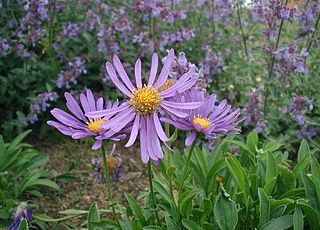
Aster alpinus, the alpine aster or blue alpine daisy, is a species of flowering plant in the family Asteraceae, native to the mountains of Europe, with a subspecies native to Canada and the United States. This herbaceous perennial has purple, pink, or blue flowers in summer.

Croton alabamensis, known as Alabama croton, is a rare plant endemic to Texas and Alabama in the Southeastern United States.

Butomus is the only known genus in the plant family Butomaceae, native to Europe and Asia. It is considered invasive in some parts of the United States.
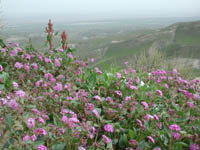
Abronia pogonantha is a species of flowering plant in the four o'clock family (Nyctaginaceae) known by the common name Mojave sand-verbena. It is native to California and Nevada, where it grows in the Mojave Desert, adjacent hills and mountains, and parts of the San Joaquin Valley in the Central Valley.
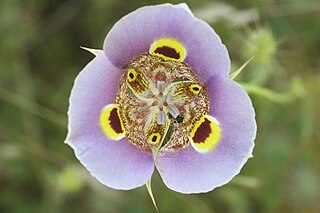
Calochortus superbus is a North American species of flowering plants in the lily family known by the common name superb mariposa lily. It is endemic to California, a common member of the flora in several types of habitat across much of the state. It is most abundant in the Coast Ranges and in the Foothills of the Sierra Nevada.

Chaenactis nevadensis, with the common name Nevada dustymaiden, is a North American species of flowering plant in the daisy family.

Adelpha fessonia, the band-celled sister or Mexican sister, is a species of butterfly of the family Nymphalidae. It is found in Panama north through Central America to Mexico. It is a periodic resident in the lower Rio Grande Valley, Texas.

Arnica dealbata is a species of Californian plants in the tarweed tribe within the aster family
Meconella oregana, the white fairypoppy, is a plant species native to Oregon, California, Washington and British Columbia. It grows on sandy bluffs, meadows and stream banks, at elevations of less than 300 m.
Eriogonum zionis, common name Zion wild buckwheat or Point Sublime wild buckwheat, is a plant species native to the southwestern United States, the states of Utah and Arizona. It grows on sandy or gravelly soil at elevations of 1300–2300 m.
Antennaria densifolia, the denseleaf pussytoes, is a North American species of plants in the family Asteraceae. It is native to western Canada and the US states of Alaska and Montana. It grows in subalpine-alpine limestone talus.

Aristolochia reticulata, the Red River snakeroot, Texas Dutchman's pipe, or Texas pipevine, is a species of perennial herb in the family Aristolochiaceae, and endemic to Arkansas, Louisiana, Oklahoma, and Texas. Its habit is erect to sprawling, up to 0.4 meters in height. It flowers in summer and late spring, and summer and grows in moist, sandy soils.

Dirca decipiens, the Ozark leatherwood, is a deciduous shrub endemic to northwestern Arkansas, southeastern Kansas, and southwestern Missouri. It is distinguished from the more widespread eastern leatherwood by its sessile fruits and finely hairy leaves and stems.

Pelazoneuron ovatum, synonym Thelypteris ovata, the ovate marsh fern or ovate maiden fern, is a species of fern in the Thelypteridaceae family. Native to the southeastern United States, this fern can be found in riverbanks and moist canyons. In Georgia it can be found in the Coastal Plain.
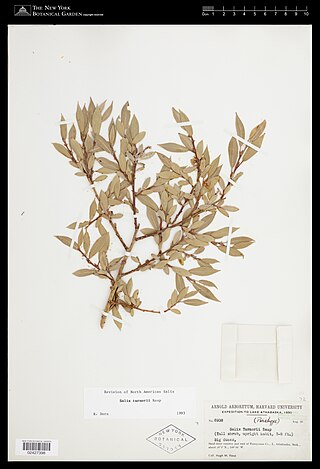
Salix turnorii, also known as Turnor's willow, is a species of willow. It is endemic to the Athabasca Sand Dunes Provincial Park in Saskatchewan, Canada. It is listed as imperiled by NatureServe.

Ulota crispa, the crisped pincushion moss, is a species of acrocarpous moss in the genus Ulota native to eastern North America. It is generally found in tight mounds on tree bark.


















